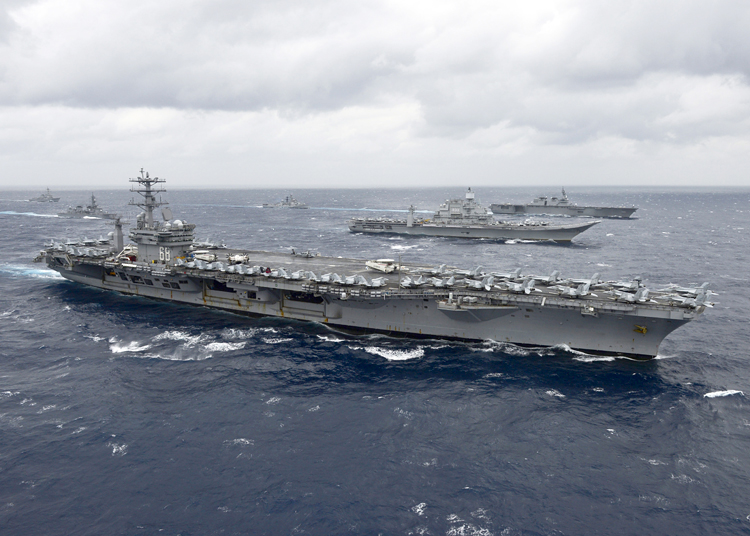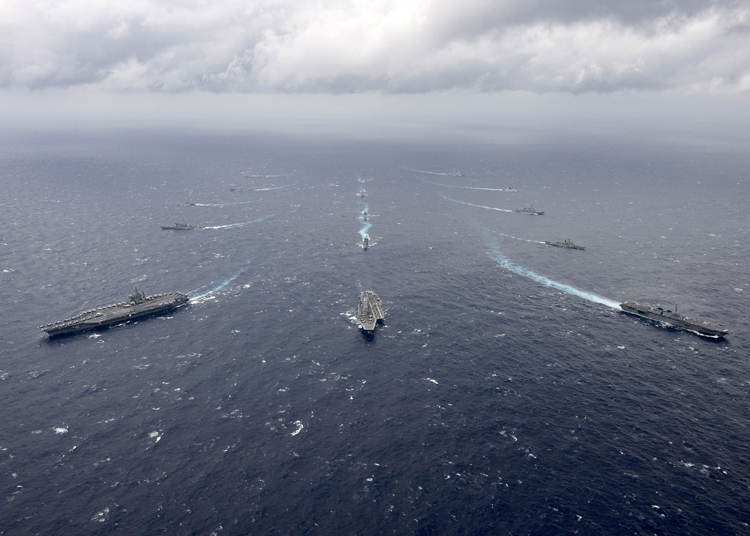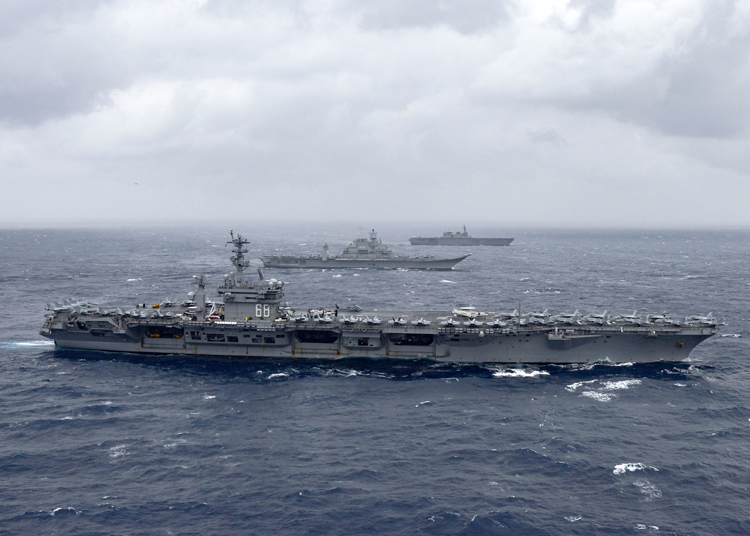INDIAN ARMED FORCES CHIEFS ON
OUR RELENTLESS AND FOCUSED PUBLISHING EFFORTS

SP Guide Publications puts forth a well compiled articulation of issues, pursuits and accomplishments of the Indian Army, over the years

I am confident that SP Guide Publications would continue to inform, inspire and influence.

My compliments to SP Guide Publications for informative and credible reportage on contemporary aerospace issues over the past six decades.
- Prime Minister witnesses 'Bharat Shakti' – a Tri-Services Firing and Manoeuvre Exercise in Pokhran, Rajasthan
- Interim Defence Budget 2024-25 — An Analysis
- Union Defence budget 2024
- Prime Minister Modi Commemorates Indian Navy Day in a Grand Ceremony
- Prime Minister Modi Flies in the LCA Tejas
- New Chapter in India-Italy Defence Ties
- Airpower beyond Boundaries
Malabar 2017 — Guilty conscience pricks China
 |
By Lt. General P.C. Katoch (Retd) Former Director General of Information Systems, Indian Army |
During Malabar 2016 conducted in the Western Pacific, the Chinese media had gone ballistic alleging that the “Malabar naval exercise involving the Indian, US and Japanese navies is designed to “target” China’s submarines in the East and South China Seas and to back America’s Asia-Pacific rebalance strategy”. Malabar series of joint exercises began in 1992, with the navies of US and India in the Indian Ocean. Since Japan joined in 2007, it has alternated between the West Pacific and the Indian Ocean. Malabar 2016, held in June 2016, was at that time the largest-ever India-US-Japan joint exercise which involved 11 vessels and 8,000 personnel.
The PLA Navy (PLAN) tailed and monitored the exercise from a distance. The self-induced gas in Communist Party of China was evident when its mouthpiece media referring to Malabar 2016 stated, “The Malabar exercise has always been led by the US, with Japan and India being just partners with varied purposes. This will cripple the actual effects of the exercise. In fact, this kind of exercise is unlikely to impair China’s presence in the East China Sea, except for flaring up tensions in the waters and producing frictions.” However, the 21st edition of the Malabar naval exercise, “Malabar 2017’, evoked a different response from the Chinese media saying, "We hope that this kind of relationship and cooperation will not be directed against a third country and that it will be conducive to the regional peace and security." Having three major navies exercising together obviously spooked China especially since the US describes these exercise as a "series of complex, high-end war-fighting exercises conducted to advance multi-national maritime relationships and mutual security issues", at a time when China is flexing her naval muscles in the Indian Ocean Region (IOR) especially in Gwadar and Djibouti and her deliberate intrusion in Bhutan has reached an impasse. However, China reportedly did send a demarche to India asking the purpose of Malabar 2017 as if the Indian Ocean is the personal fiefdom of the CPC. It is actually a stupid query with China having just concluded joint naval drills with Pakistan and with Iran in the Arabian Sea and Persian Gulf respectively. It may be recalled that during Prime Minister Narendra Modi’s recent visit to the US, President Trump had stated that one of the biggest joint naval exercise would be conducted in the India Ocean shortly. Before Malabar 2017, Indian Navy had recorded unusual surge in the number of Chinese warships and submarines entering the IOR over last two months including ‘civilian’ ship ‘Haiwang Xiang’ meant for surveillance.
The eight-day long Malabar 2017 exercise that kicked off on July 10 naturally had an anti-submarine warfare component, and was more complicated, with all three navies bringing in their aircraft carriers. The Indian Navy was represented by aircraft carrier INS Vikramaditya with its air wing, guided missile destroyer Ranvir, indigenous stealth frigates Shivalik and Sahyadri, indigenous ASW corvette Kamorta, missile corvettes Kora and Kirpan, one Sindhughosh class submarine, fleet tanker INS Jyoti and Long Range Maritime Patrol Aircraft P8I. The US Navy was represented by the ships from the Nimitz Carrier Strike Group and other units from the US 7th Fleet; Nimitz-class aircraft carrier Nimitz and a Los Angeles-class attack submarine among other ships. Japan was represented by JS Izumo, a helicopter carrier with helicopters and JS Sazanami, a missile destroyer. The world was assured that the joint exercise had nothing to do with China or any other country despite Beijing’s all around aggressive projection of power.
If China was not convinced it is the guilty conscience of a rogue nation that wantonly disregards international norms, freedom of sea lanes of communications (SLOCS) and global commons. Both PM Modi and President Trump recently reiterated the "importance of respecting freedom of navigation" and called on countries to "resolve territorial and maritime disputes peacefully and in accordance with international law." The scope of Malabar 2017 included wide-ranging professional interactions during the ‘Harbour Phase’ at Chennai from July 10-13 and a diverse range of operational activities at sea during the ‘Sea Phase’ from July 14-17. The thrust of the exercise at sea was on aircraft carrier operations, air defence, anti-submarine warfare, surface warfare, visit board search and seizure, search and rescue, joint manoeuvres and tactical procedures. During the ‘sea phase’ in the last four days of Malabar 2017, naval manoeuvres were undertaken to include swift ships movement of at close quarters to streamline procedure in ship handling and communications and cross-deck landings by helicopters.
The exercise encounters some very rough weather but despite the rough seas, the ships and aircraft of the three navies carried out their assigned tasks in a cohesive manner. Our naval Seaking helicopter undertook transfer of Japanese personnel to INS Vikramaditya as part of crew exchange program, followed by flying operations undertaken by the helicopters of US naval ships. India and Australia recently conducted a joint naval exercise but India so far has resisted Australian Navy joining the Malabar exercise despite the US and Japan urging India to do so. Australia is China’s largest trading partner with very close political relations between the two nations. Australian Foreign Minister Julie Bishop who visited India recently said, “Australia has a positive engagement with China, but it (China) has an assertive foreign policy especially in the South China Sea. India is apparently worried that China will step up activities in the Indian Ocean in response to the Malabar exercise and inclusion of Australia will raise Chinese suspicions more that Malabar is a loose ‘coalition’ against China. But the fact is that China couldn’t care less whether Australia joins Malabar or not. China is already building infrastructure in Sri Lanka, Bangladesh and Pakistan, which is only a small part of Xi Jinping’s prime project of the ‘China Dream’ surpassing the US.








